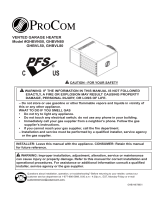
8
Combustion Air and Venting
The installer should compensate for any lou-
vers, grilles or screens when determining the
free air of the opening. The installer should
refer the louver or grille manufacturer’s
instruction for determining free area. In
absence of the manufacturer’s instructions the
installer should use the following as a guide-
line:
- Wood louvers will provide 20 to 25%
free area
- Metal louvers or grilles will provide 60
to 75% free air
Installers should lock louvers in the open posi-
tion or provide an interlock system to prove the
louvers are in the open position prior to opera-
tion of the ELITE.
Removal of an Existing Boiler from a
Common Vent System
For installations in which the ELITE is
replacing an existing boiler / hot water
heater system, which was connected to a
common vent system with other appli-
ances, the following steps shall be con-
ducted with each remaining appliance
connected to the common venting system:
1. Any unused openings in the common
venting system must be sealed.
2. A visual inspection of the venting sys-
tem must be conducted for proper siz-
ing and horizontal pitch.
The inspec-
tion should ensure no blockage or
restriction is within the vent system,
and there is no leakage, corrosion or
other items, which could cause an
unsafe condition.
3. To adequately test the venting system,
close all exterior doors and windows
and all doors between the area contain-
ing the remaining appliances connected
to the common vent system and other
areas of the building. Turn on any
clothes dryers and any other gas appli-
ance not connected to the common vent
system. Turn on all exhaust fans, i.e.
range hoods and bathroom exhaust
fans, preferably at maximum speed.
Close any fireplace dampers.
4. Place in operation the first appliance
being inspected that is connected to the
common vent system. The remaining
appliances should not be in operation.
Follow the appliance’s lighting instruc-
tions and adjust the thermostat to allow
the appliance to operate continuously.
5. Test for spillage at the draft hood relief
opening after 5 minutes of main burner
operation. Spillage can be detected
using the flame of a match or candle or
with smoke from a cigarette.
6. Once it has been determined that each
remaining appliance connected to the
common vent system is properly vent-
ed, return doors, windows, exhaust
fans, fireplace dampers and any oper-
ating gas appliance to their previous
condition.
Should any improper operation of the common
venting system be detected in the outlined test,
the condition should be corrected so the vent
system conforms with the National Fuel Gas
Code, NFPA 54/ ANSI Z223.1 - latest edition.
Canadian installations must conform with
B149.1 or 149.2 Installation Code.
BEST PRACTICES
























